Networking Technologies Report: Unit 24, Networking Technologies
VerifiedAdded on 2023/03/30
|19
|3875
|466
Report
AI Summary
This report provides a comprehensive overview of networking technologies, focusing on the design and implementation of a Local Area Network (LAN) for Beta Communication Ltd. It begins with an introduction to networks, explaining their function and the benefits of networking technologies, followed by a detailed exploration of different network types, including LAN, WAN, PAN, and MAN, along with their respective advantages and limitations. The report then delves into network topologies, such as Mesh, Star, Bus, Ring, and Tree, analyzing their characteristics and suitability for various applications. Furthermore, it examines the impact of network technology, communication, and standards, covering the Ethernet protocol. The report also addresses the roles of software and hardware components, different server types, and the interdependence of workstation hardware. It includes illustrations to clarify complex concepts and concludes with a summary of the key findings, providing valuable insights into the practical aspects of network design and management. The report is structured to meet the requirements of a BTEC HND in Computing and Systems Development unit on Networking Technologies.
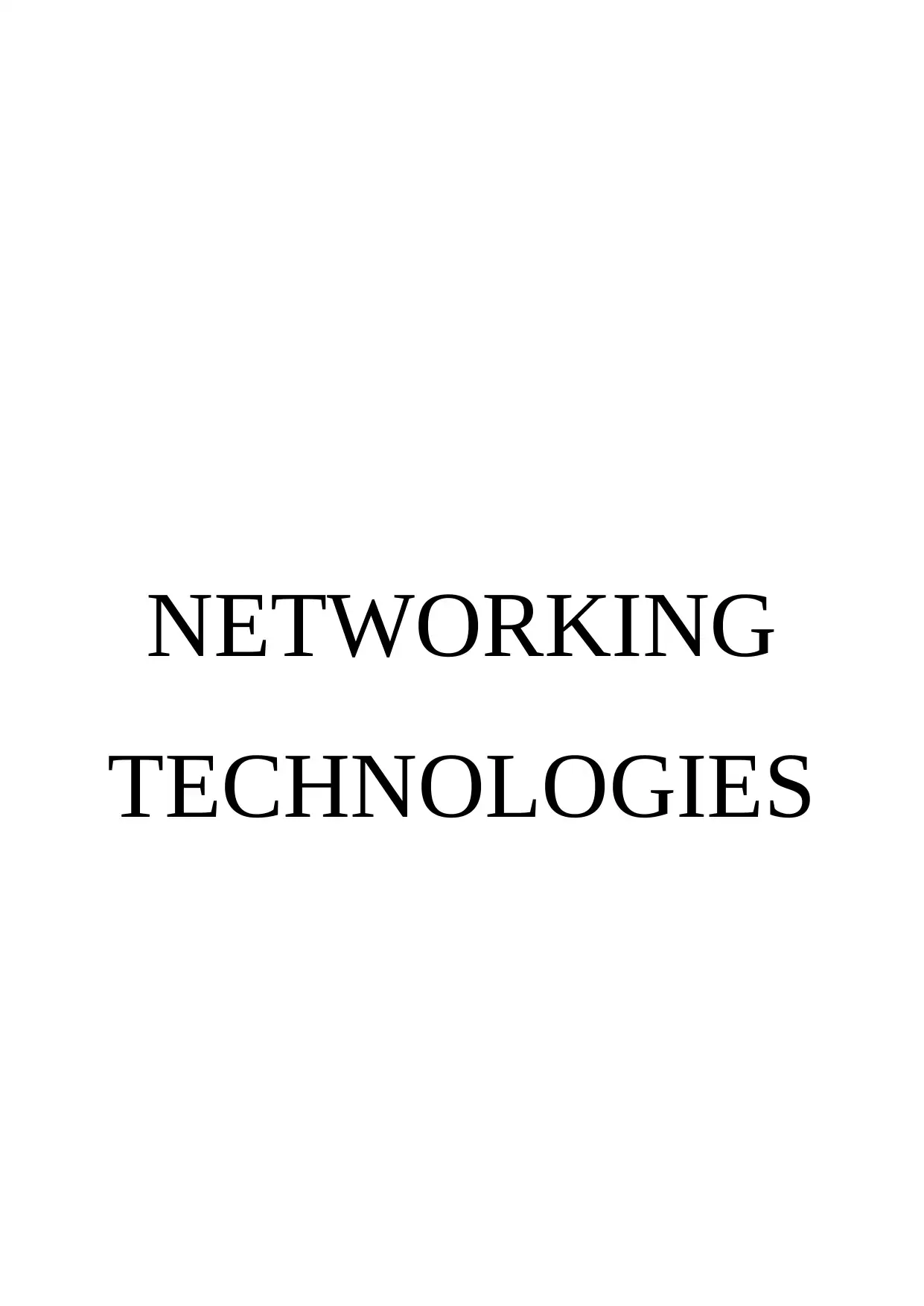
NETWORKING
TECHNOLOGIES
TECHNOLOGIES
Paraphrase This Document
Need a fresh take? Get an instant paraphrase of this document with our AI Paraphraser
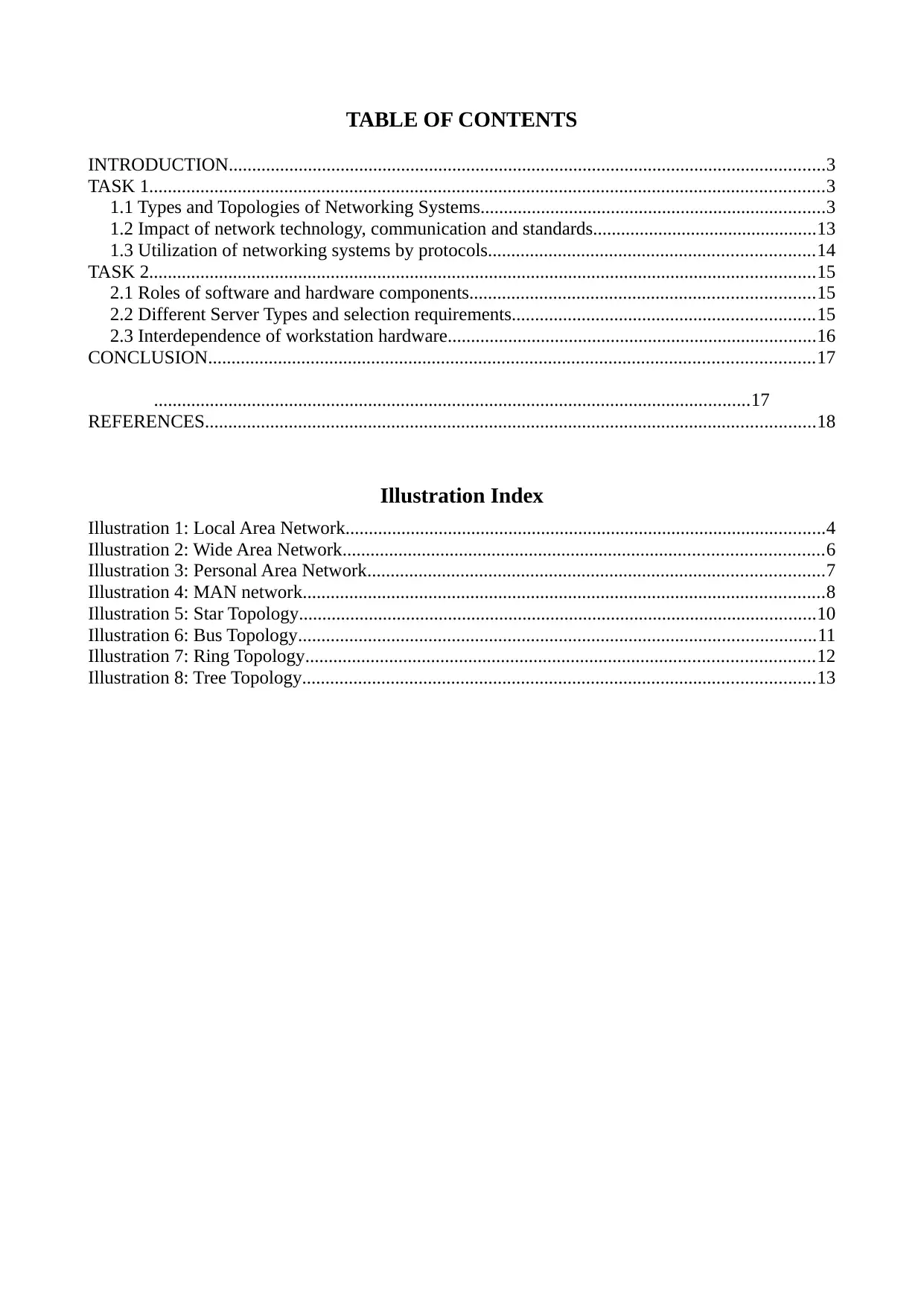
TABLE OF CONTENTS
INTRODUCTION................................................................................................................................3
TASK 1.................................................................................................................................................3
1.1 Types and Topologies of Networking Systems..........................................................................3
1.2 Impact of network technology, communication and standards................................................13
1.3 Utilization of networking systems by protocols......................................................................14
TASK 2...............................................................................................................................................15
2.1 Roles of software and hardware components..........................................................................15
2.2 Different Server Types and selection requirements.................................................................15
2.3 Interdependence of workstation hardware...............................................................................16
CONCLUSION..................................................................................................................................17
................................................................................................................................17
REFERENCES...................................................................................................................................18
Illustration Index
Illustration 1: Local Area Network.......................................................................................................4
Illustration 2: Wide Area Network.......................................................................................................6
Illustration 3: Personal Area Network..................................................................................................7
Illustration 4: MAN network................................................................................................................8
Illustration 5: Star Topology...............................................................................................................10
Illustration 6: Bus Topology...............................................................................................................11
Illustration 7: Ring Topology.............................................................................................................12
Illustration 8: Tree Topology..............................................................................................................13
INTRODUCTION................................................................................................................................3
TASK 1.................................................................................................................................................3
1.1 Types and Topologies of Networking Systems..........................................................................3
1.2 Impact of network technology, communication and standards................................................13
1.3 Utilization of networking systems by protocols......................................................................14
TASK 2...............................................................................................................................................15
2.1 Roles of software and hardware components..........................................................................15
2.2 Different Server Types and selection requirements.................................................................15
2.3 Interdependence of workstation hardware...............................................................................16
CONCLUSION..................................................................................................................................17
................................................................................................................................17
REFERENCES...................................................................................................................................18
Illustration Index
Illustration 1: Local Area Network.......................................................................................................4
Illustration 2: Wide Area Network.......................................................................................................6
Illustration 3: Personal Area Network..................................................................................................7
Illustration 4: MAN network................................................................................................................8
Illustration 5: Star Topology...............................................................................................................10
Illustration 6: Bus Topology...............................................................................................................11
Illustration 7: Ring Topology.............................................................................................................12
Illustration 8: Tree Topology..............................................................................................................13
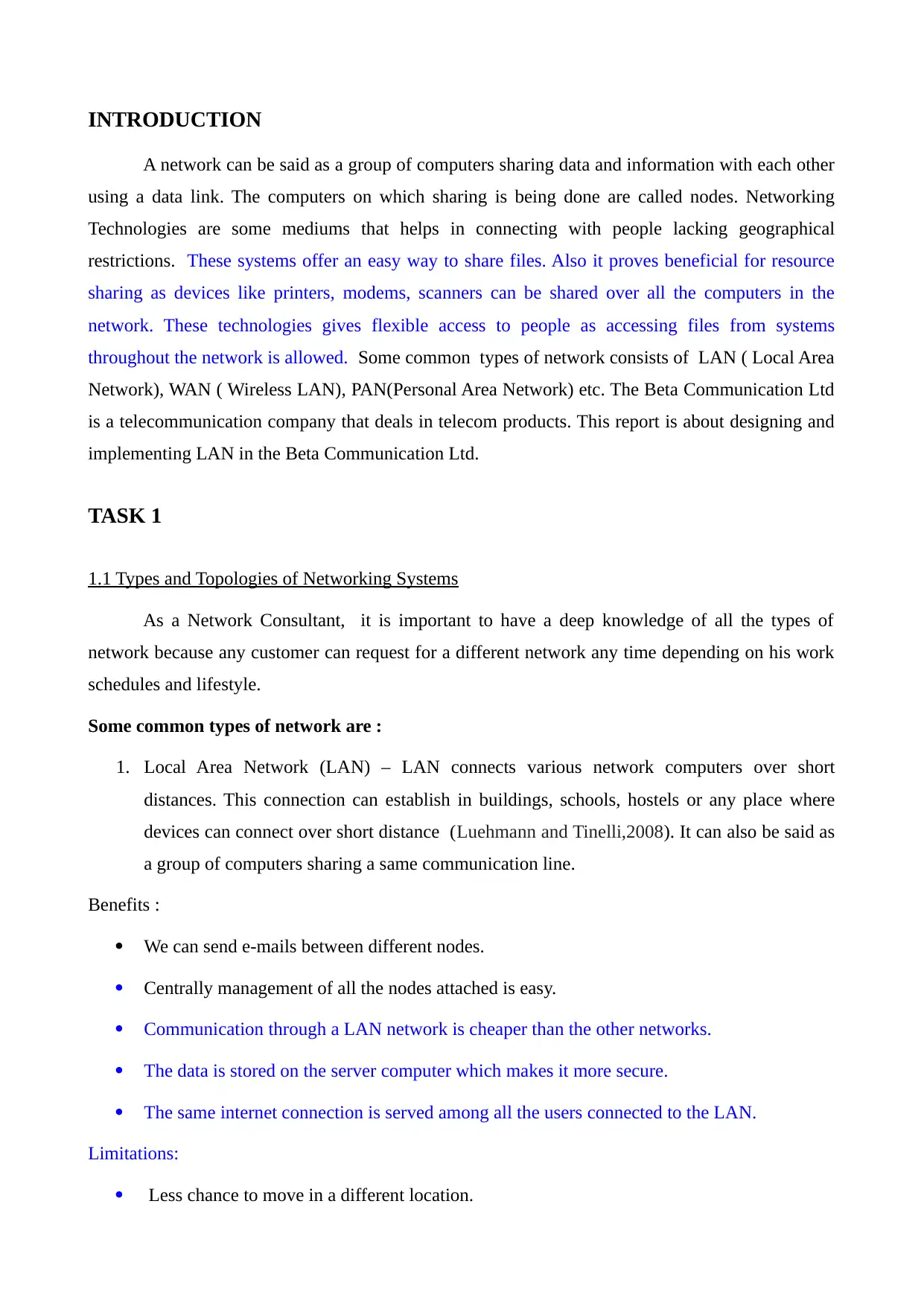
INTRODUCTION
A network can be said as a group of computers sharing data and information with each other
using a data link. The computers on which sharing is being done are called nodes. Networking
Technologies are some mediums that helps in connecting with people lacking geographical
restrictions. These systems offer an easy way to share files. Also it proves beneficial for resource
sharing as devices like printers, modems, scanners can be shared over all the computers in the
network. These technologies gives flexible access to people as accessing files from systems
throughout the network is allowed. Some common types of network consists of LAN ( Local Area
Network), WAN ( Wireless LAN), PAN(Personal Area Network) etc. The Beta Communication Ltd
is a telecommunication company that deals in telecom products. This report is about designing and
implementing LAN in the Beta Communication Ltd.
TASK 1
1.1 Types and Topologies of Networking Systems
As a Network Consultant, it is important to have a deep knowledge of all the types of
network because any customer can request for a different network any time depending on his work
schedules and lifestyle.
Some common types of network are :
1. Local Area Network (LAN) – LAN connects various network computers over short
distances. This connection can establish in buildings, schools, hostels or any place where
devices can connect over short distance (Luehmann and Tinelli,2008). It can also be said as
a group of computers sharing a same communication line.
Benefits :
We can send e-mails between different nodes.
Centrally management of all the nodes attached is easy.
Communication through a LAN network is cheaper than the other networks.
The data is stored on the server computer which makes it more secure.
The same internet connection is served among all the users connected to the LAN.
Limitations:
Less chance to move in a different location.
A network can be said as a group of computers sharing data and information with each other
using a data link. The computers on which sharing is being done are called nodes. Networking
Technologies are some mediums that helps in connecting with people lacking geographical
restrictions. These systems offer an easy way to share files. Also it proves beneficial for resource
sharing as devices like printers, modems, scanners can be shared over all the computers in the
network. These technologies gives flexible access to people as accessing files from systems
throughout the network is allowed. Some common types of network consists of LAN ( Local Area
Network), WAN ( Wireless LAN), PAN(Personal Area Network) etc. The Beta Communication Ltd
is a telecommunication company that deals in telecom products. This report is about designing and
implementing LAN in the Beta Communication Ltd.
TASK 1
1.1 Types and Topologies of Networking Systems
As a Network Consultant, it is important to have a deep knowledge of all the types of
network because any customer can request for a different network any time depending on his work
schedules and lifestyle.
Some common types of network are :
1. Local Area Network (LAN) – LAN connects various network computers over short
distances. This connection can establish in buildings, schools, hostels or any place where
devices can connect over short distance (Luehmann and Tinelli,2008). It can also be said as
a group of computers sharing a same communication line.
Benefits :
We can send e-mails between different nodes.
Centrally management of all the nodes attached is easy.
Communication through a LAN network is cheaper than the other networks.
The data is stored on the server computer which makes it more secure.
The same internet connection is served among all the users connected to the LAN.
Limitations:
Less chance to move in a different location.
⊘ This is a preview!⊘
Do you want full access?
Subscribe today to unlock all pages.

Trusted by 1+ million students worldwide
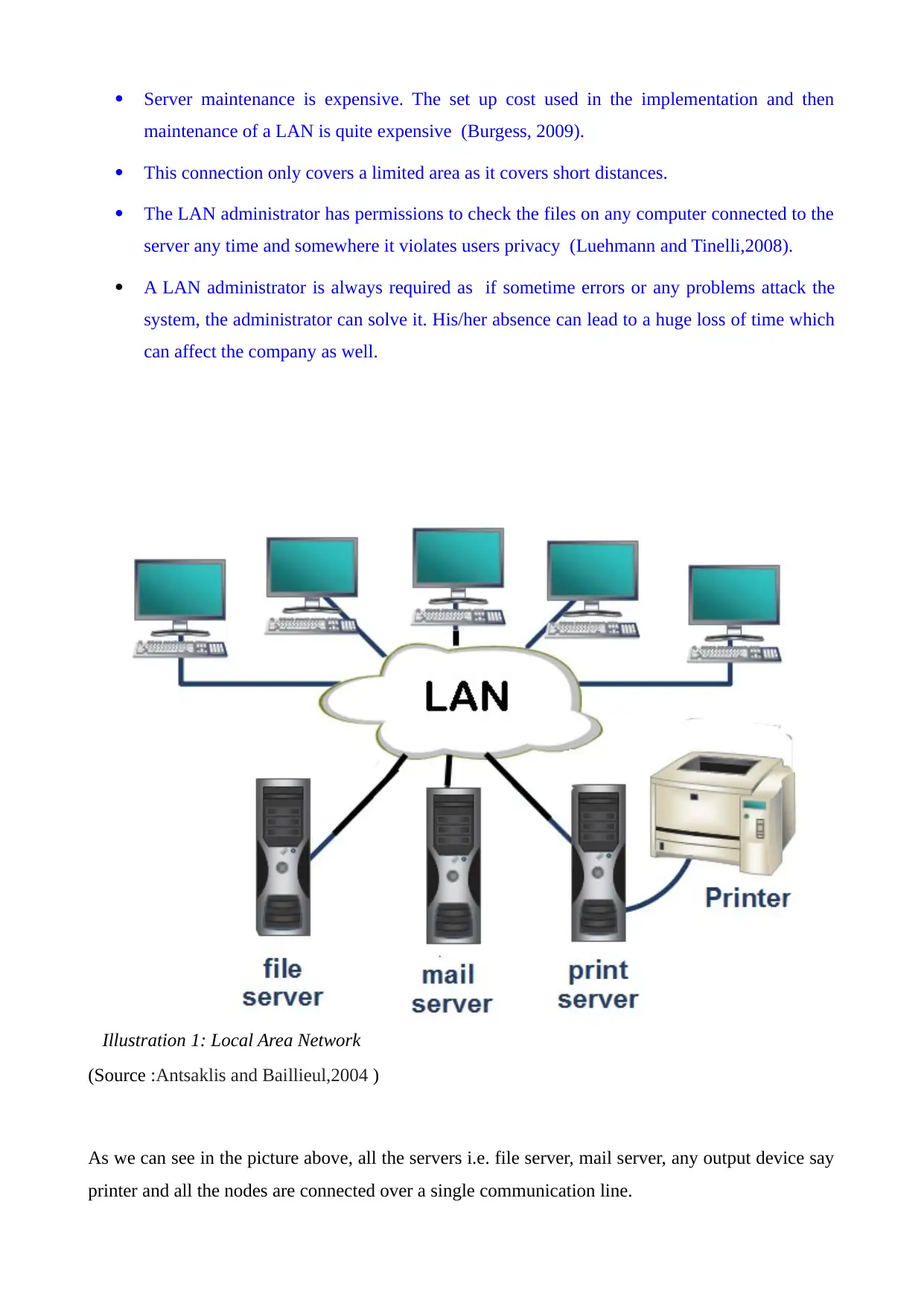
Server maintenance is expensive. The set up cost used in the implementation and then
maintenance of a LAN is quite expensive (Burgess, 2009).
This connection only covers a limited area as it covers short distances.
The LAN administrator has permissions to check the files on any computer connected to the
server any time and somewhere it violates users privacy (Luehmann and Tinelli,2008).
A LAN administrator is always required as if sometime errors or any problems attack the
system, the administrator can solve it. His/her absence can lead to a huge loss of time which
can affect the company as well.
(Source :Antsaklis and Baillieul,2004 )
As we can see in the picture above, all the servers i.e. file server, mail server, any output device say
printer and all the nodes are connected over a single communication line.
Illustration 1: Local Area Network
maintenance of a LAN is quite expensive (Burgess, 2009).
This connection only covers a limited area as it covers short distances.
The LAN administrator has permissions to check the files on any computer connected to the
server any time and somewhere it violates users privacy (Luehmann and Tinelli,2008).
A LAN administrator is always required as if sometime errors or any problems attack the
system, the administrator can solve it. His/her absence can lead to a huge loss of time which
can affect the company as well.
(Source :Antsaklis and Baillieul,2004 )
As we can see in the picture above, all the servers i.e. file server, mail server, any output device say
printer and all the nodes are connected over a single communication line.
Illustration 1: Local Area Network
Paraphrase This Document
Need a fresh take? Get an instant paraphrase of this document with our AI Paraphraser
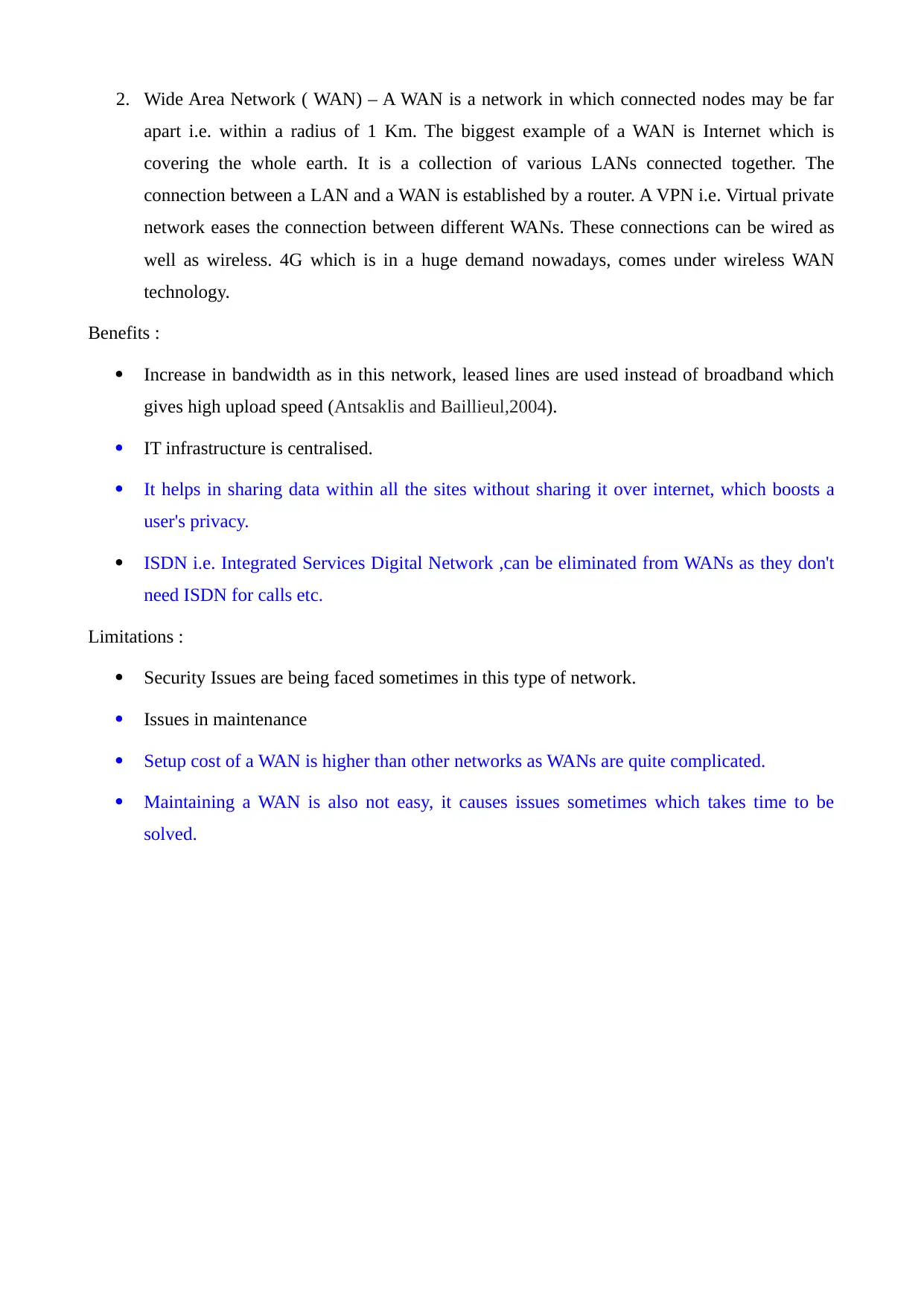
2. Wide Area Network ( WAN) – A WAN is a network in which connected nodes may be far
apart i.e. within a radius of 1 Km. The biggest example of a WAN is Internet which is
covering the whole earth. It is a collection of various LANs connected together. The
connection between a LAN and a WAN is established by a router. A VPN i.e. Virtual private
network eases the connection between different WANs. These connections can be wired as
well as wireless. 4G which is in a huge demand nowadays, comes under wireless WAN
technology.
Benefits :
Increase in bandwidth as in this network, leased lines are used instead of broadband which
gives high upload speed (Antsaklis and Baillieul,2004).
IT infrastructure is centralised.
It helps in sharing data within all the sites without sharing it over internet, which boosts a
user's privacy.
ISDN i.e. Integrated Services Digital Network ,can be eliminated from WANs as they don't
need ISDN for calls etc.
Limitations :
Security Issues are being faced sometimes in this type of network.
Issues in maintenance
Setup cost of a WAN is higher than other networks as WANs are quite complicated.
Maintaining a WAN is also not easy, it causes issues sometimes which takes time to be
solved.
apart i.e. within a radius of 1 Km. The biggest example of a WAN is Internet which is
covering the whole earth. It is a collection of various LANs connected together. The
connection between a LAN and a WAN is established by a router. A VPN i.e. Virtual private
network eases the connection between different WANs. These connections can be wired as
well as wireless. 4G which is in a huge demand nowadays, comes under wireless WAN
technology.
Benefits :
Increase in bandwidth as in this network, leased lines are used instead of broadband which
gives high upload speed (Antsaklis and Baillieul,2004).
IT infrastructure is centralised.
It helps in sharing data within all the sites without sharing it over internet, which boosts a
user's privacy.
ISDN i.e. Integrated Services Digital Network ,can be eliminated from WANs as they don't
need ISDN for calls etc.
Limitations :
Security Issues are being faced sometimes in this type of network.
Issues in maintenance
Setup cost of a WAN is higher than other networks as WANs are quite complicated.
Maintaining a WAN is also not easy, it causes issues sometimes which takes time to be
solved.
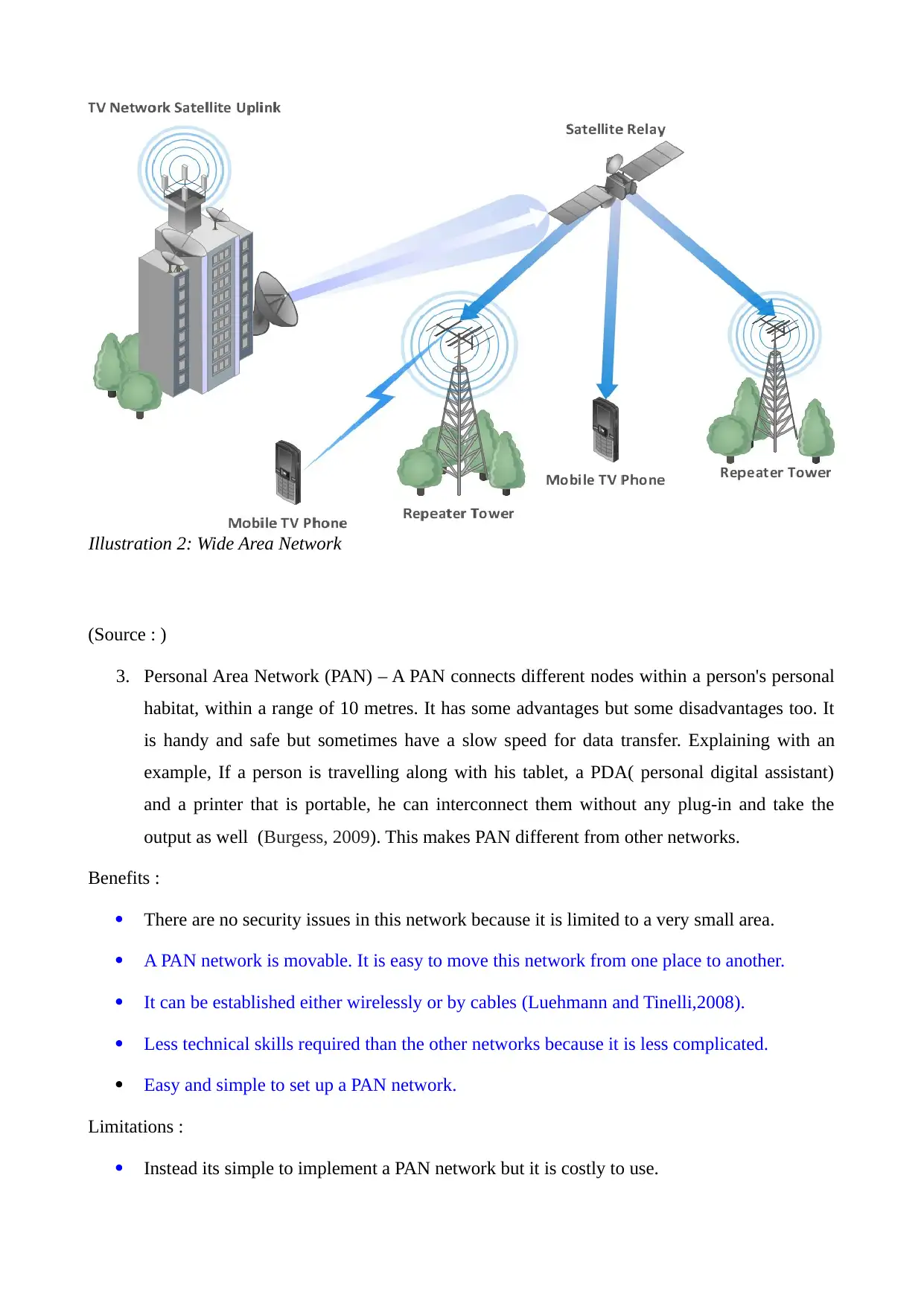
(Source : )
3. Personal Area Network (PAN) – A PAN connects different nodes within a person's personal
habitat, within a range of 10 metres. It has some advantages but some disadvantages too. It
is handy and safe but sometimes have a slow speed for data transfer. Explaining with an
example, If a person is travelling along with his tablet, a PDA( personal digital assistant)
and a printer that is portable, he can interconnect them without any plug-in and take the
output as well (Burgess, 2009). This makes PAN different from other networks.
Benefits :
There are no security issues in this network because it is limited to a very small area.
A PAN network is movable. It is easy to move this network from one place to another.
It can be established either wirelessly or by cables (Luehmann and Tinelli,2008).
Less technical skills required than the other networks because it is less complicated.
Easy and simple to set up a PAN network.
Limitations :
Instead its simple to implement a PAN network but it is costly to use.
Illustration 2: Wide Area Network
3. Personal Area Network (PAN) – A PAN connects different nodes within a person's personal
habitat, within a range of 10 metres. It has some advantages but some disadvantages too. It
is handy and safe but sometimes have a slow speed for data transfer. Explaining with an
example, If a person is travelling along with his tablet, a PDA( personal digital assistant)
and a printer that is portable, he can interconnect them without any plug-in and take the
output as well (Burgess, 2009). This makes PAN different from other networks.
Benefits :
There are no security issues in this network because it is limited to a very small area.
A PAN network is movable. It is easy to move this network from one place to another.
It can be established either wirelessly or by cables (Luehmann and Tinelli,2008).
Less technical skills required than the other networks because it is less complicated.
Easy and simple to set up a PAN network.
Limitations :
Instead its simple to implement a PAN network but it is costly to use.
Illustration 2: Wide Area Network
⊘ This is a preview!⊘
Do you want full access?
Subscribe today to unlock all pages.

Trusted by 1+ million students worldwide
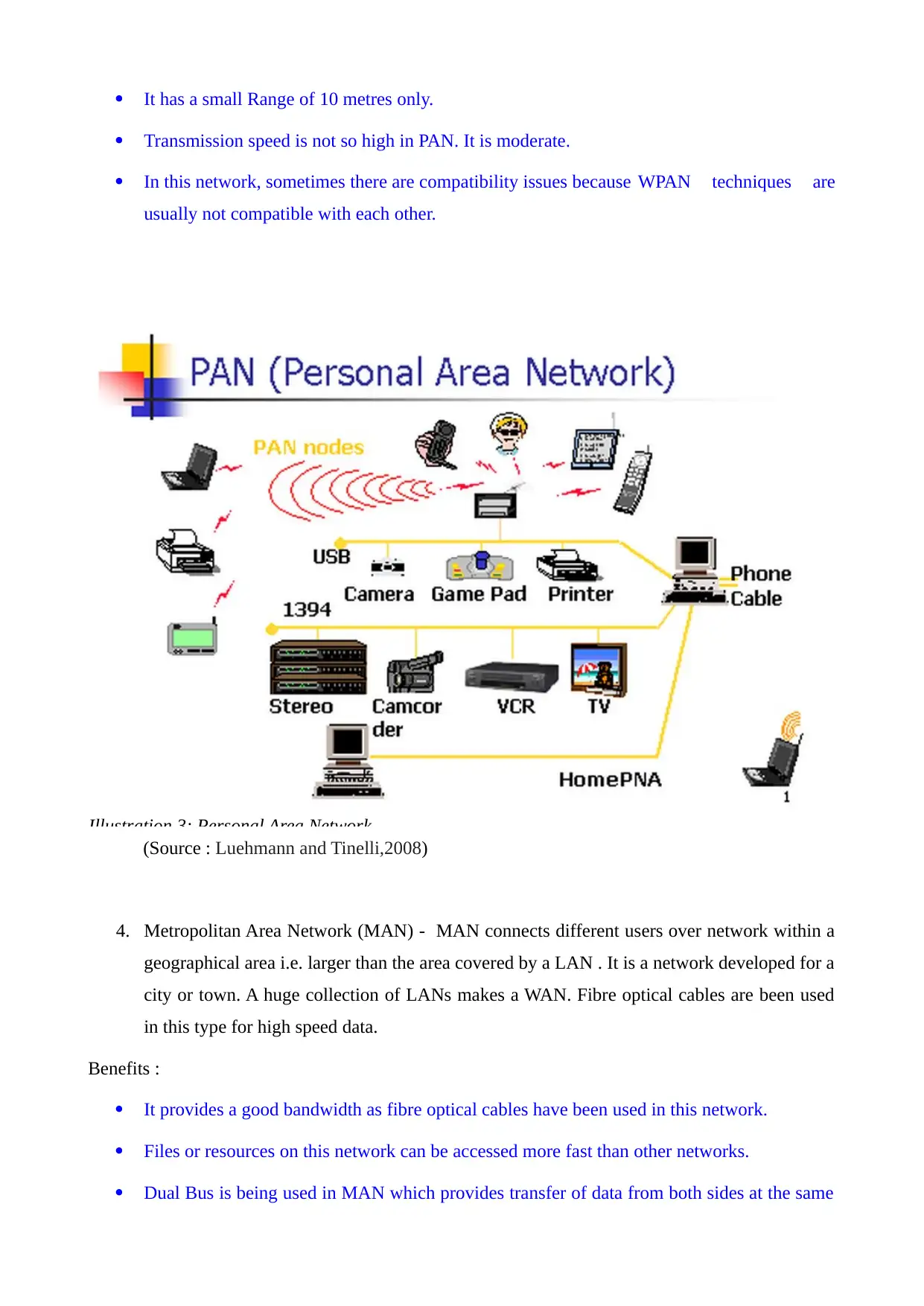
It has a small Range of 10 metres only.
Transmission speed is not so high in PAN. It is moderate.
In this network, sometimes there are compatibility issues because WPAN techniques are
usually not compatible with each other.
(Source : Luehmann and Tinelli,2008)
4. Metropolitan Area Network (MAN) - MAN connects different users over network within a
geographical area i.e. larger than the area covered by a LAN . It is a network developed for a
city or town. A huge collection of LANs makes a WAN. Fibre optical cables are been used
in this type for high speed data.
Benefits :
It provides a good bandwidth as fibre optical cables have been used in this network.
Files or resources on this network can be accessed more fast than other networks.
Dual Bus is being used in MAN which provides transfer of data from both sides at the same
Illustration 3: Personal Area Network
Transmission speed is not so high in PAN. It is moderate.
In this network, sometimes there are compatibility issues because WPAN techniques are
usually not compatible with each other.
(Source : Luehmann and Tinelli,2008)
4. Metropolitan Area Network (MAN) - MAN connects different users over network within a
geographical area i.e. larger than the area covered by a LAN . It is a network developed for a
city or town. A huge collection of LANs makes a WAN. Fibre optical cables are been used
in this type for high speed data.
Benefits :
It provides a good bandwidth as fibre optical cables have been used in this network.
Files or resources on this network can be accessed more fast than other networks.
Dual Bus is being used in MAN which provides transfer of data from both sides at the same
Illustration 3: Personal Area Network
Paraphrase This Document
Need a fresh take? Get an instant paraphrase of this document with our AI Paraphraser
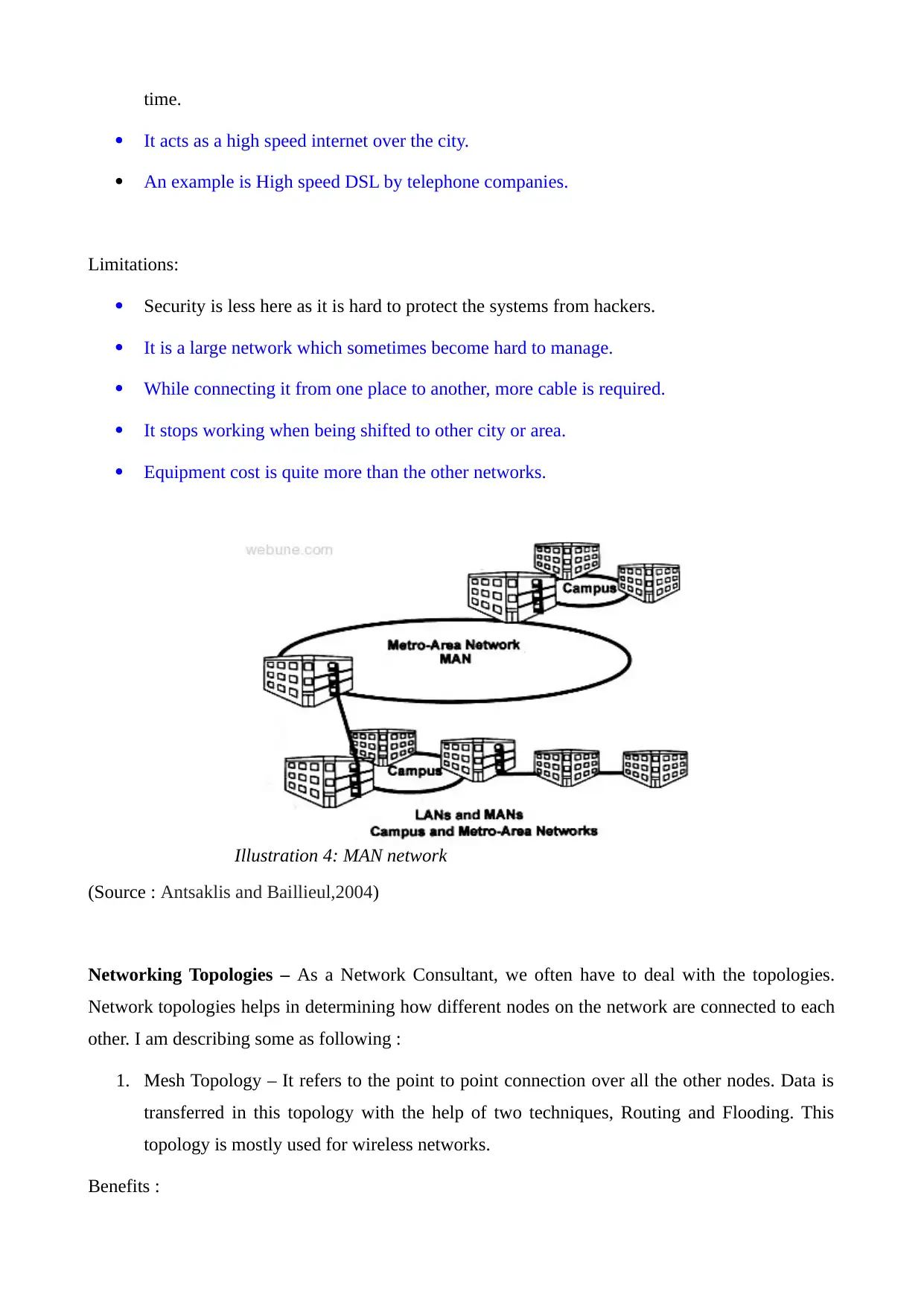
time.
It acts as a high speed internet over the city.
An example is High speed DSL by telephone companies.
Limitations:
Security is less here as it is hard to protect the systems from hackers.
It is a large network which sometimes become hard to manage.
While connecting it from one place to another, more cable is required.
It stops working when being shifted to other city or area.
Equipment cost is quite more than the other networks.
(Source : Antsaklis and Baillieul,2004)
Networking Topologies – As a Network Consultant, we often have to deal with the topologies.
Network topologies helps in determining how different nodes on the network are connected to each
other. I am describing some as following :
1. Mesh Topology – It refers to the point to point connection over all the other nodes. Data is
transferred in this topology with the help of two techniques, Routing and Flooding. This
topology is mostly used for wireless networks.
Benefits :
Illustration 4: MAN network
It acts as a high speed internet over the city.
An example is High speed DSL by telephone companies.
Limitations:
Security is less here as it is hard to protect the systems from hackers.
It is a large network which sometimes become hard to manage.
While connecting it from one place to another, more cable is required.
It stops working when being shifted to other city or area.
Equipment cost is quite more than the other networks.
(Source : Antsaklis and Baillieul,2004)
Networking Topologies – As a Network Consultant, we often have to deal with the topologies.
Network topologies helps in determining how different nodes on the network are connected to each
other. I am describing some as following :
1. Mesh Topology – It refers to the point to point connection over all the other nodes. Data is
transferred in this topology with the help of two techniques, Routing and Flooding. This
topology is mostly used for wireless networks.
Benefits :
Illustration 4: MAN network
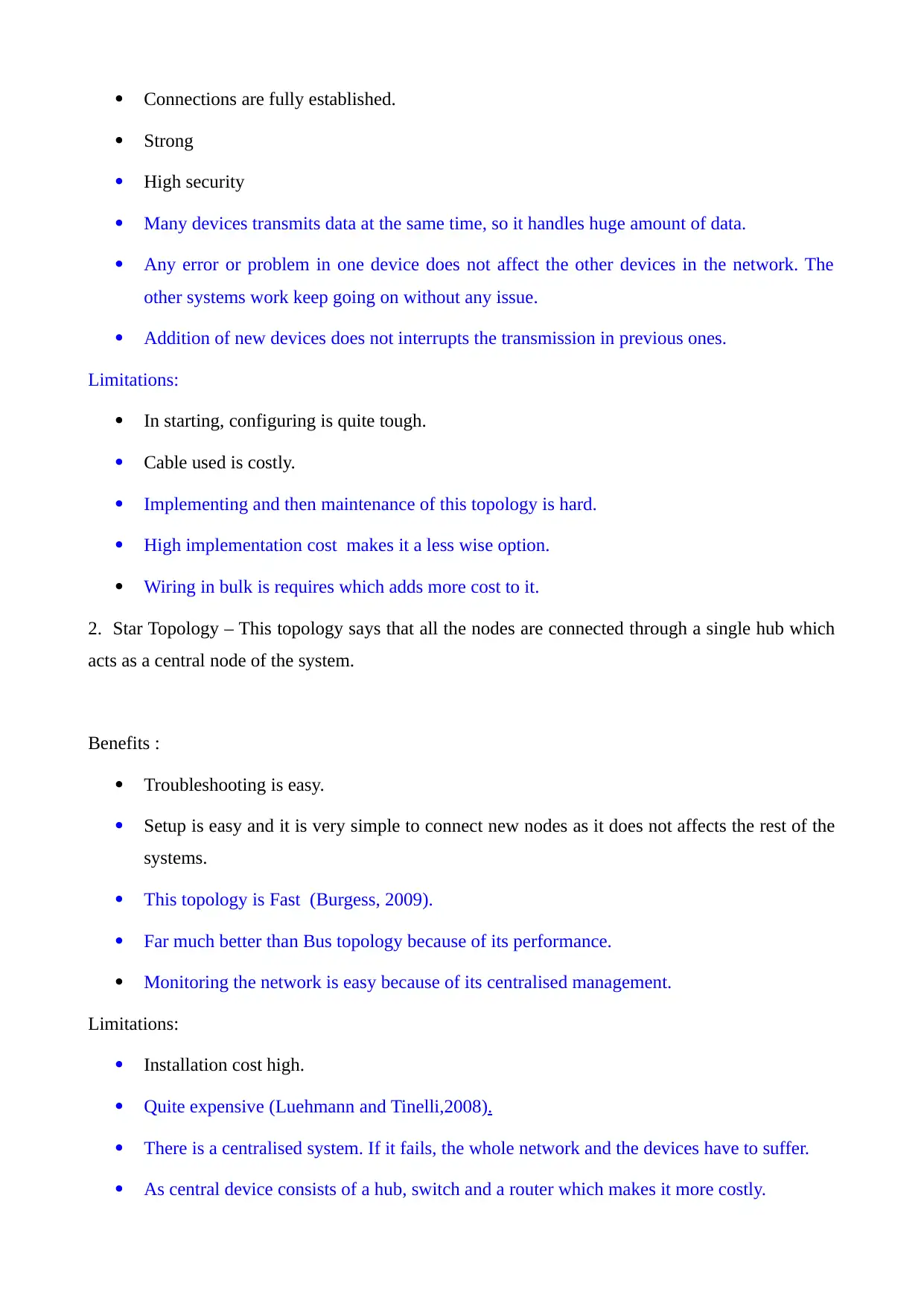
Connections are fully established.
Strong
High security
Many devices transmits data at the same time, so it handles huge amount of data.
Any error or problem in one device does not affect the other devices in the network. The
other systems work keep going on without any issue.
Addition of new devices does not interrupts the transmission in previous ones.
Limitations:
In starting, configuring is quite tough.
Cable used is costly.
Implementing and then maintenance of this topology is hard.
High implementation cost makes it a less wise option.
Wiring in bulk is requires which adds more cost to it.
2. Star Topology – This topology says that all the nodes are connected through a single hub which
acts as a central node of the system.
Benefits :
Troubleshooting is easy.
Setup is easy and it is very simple to connect new nodes as it does not affects the rest of the
systems.
This topology is Fast (Burgess, 2009).
Far much better than Bus topology because of its performance.
Monitoring the network is easy because of its centralised management.
Limitations:
Installation cost high.
Quite expensive (Luehmann and Tinelli,2008).
There is a centralised system. If it fails, the whole network and the devices have to suffer.
As central device consists of a hub, switch and a router which makes it more costly.
Strong
High security
Many devices transmits data at the same time, so it handles huge amount of data.
Any error or problem in one device does not affect the other devices in the network. The
other systems work keep going on without any issue.
Addition of new devices does not interrupts the transmission in previous ones.
Limitations:
In starting, configuring is quite tough.
Cable used is costly.
Implementing and then maintenance of this topology is hard.
High implementation cost makes it a less wise option.
Wiring in bulk is requires which adds more cost to it.
2. Star Topology – This topology says that all the nodes are connected through a single hub which
acts as a central node of the system.
Benefits :
Troubleshooting is easy.
Setup is easy and it is very simple to connect new nodes as it does not affects the rest of the
systems.
This topology is Fast (Burgess, 2009).
Far much better than Bus topology because of its performance.
Monitoring the network is easy because of its centralised management.
Limitations:
Installation cost high.
Quite expensive (Luehmann and Tinelli,2008).
There is a centralised system. If it fails, the whole network and the devices have to suffer.
As central device consists of a hub, switch and a router which makes it more costly.
⊘ This is a preview!⊘
Do you want full access?
Subscribe today to unlock all pages.

Trusted by 1+ million students worldwide
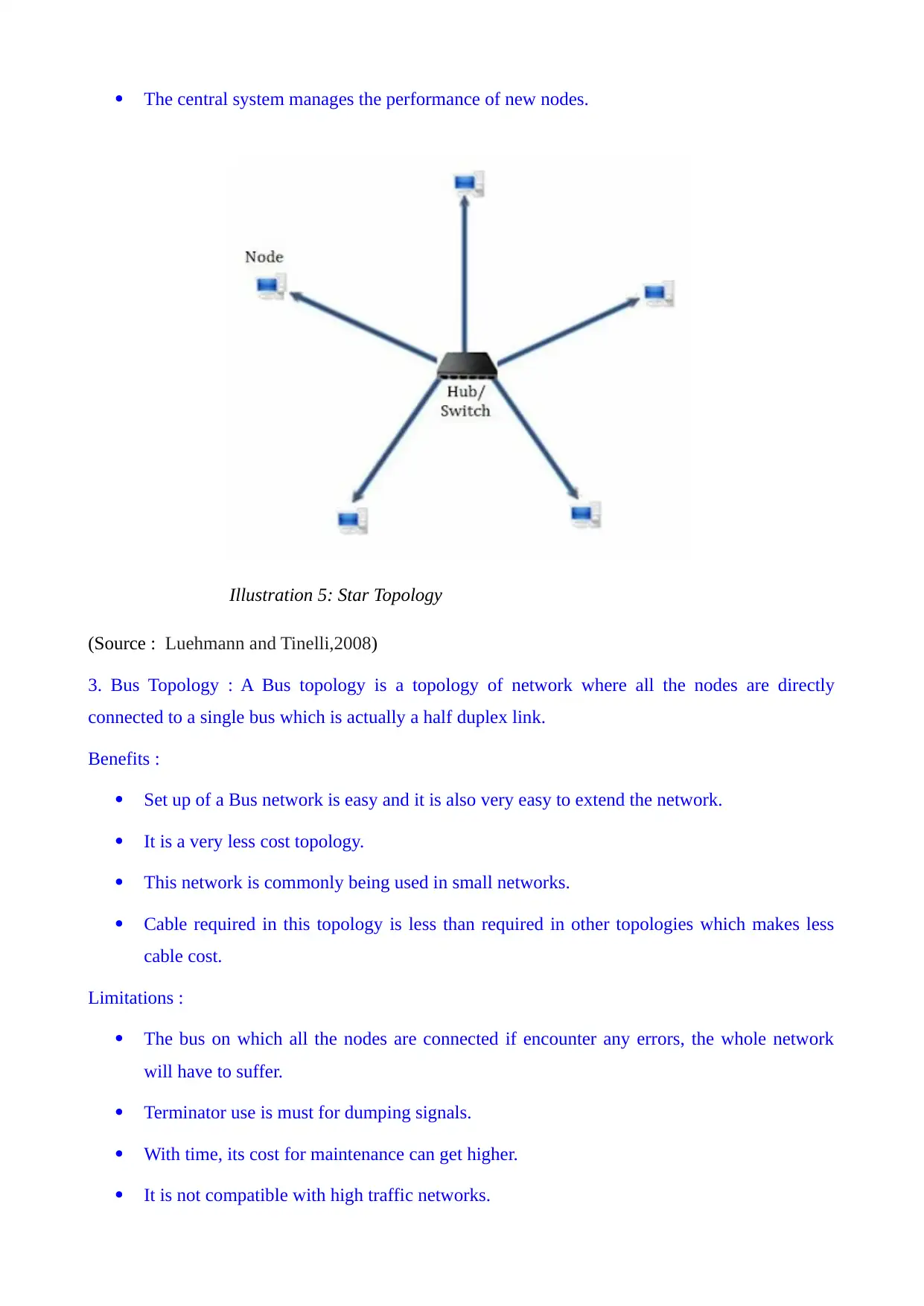
The central system manages the performance of new nodes.
(Source : Luehmann and Tinelli,2008)
3. Bus Topology : A Bus topology is a topology of network where all the nodes are directly
connected to a single bus which is actually a half duplex link.
Benefits :
Set up of a Bus network is easy and it is also very easy to extend the network.
It is a very less cost topology.
This network is commonly being used in small networks.
Cable required in this topology is less than required in other topologies which makes less
cable cost.
Limitations :
The bus on which all the nodes are connected if encounter any errors, the whole network
will have to suffer.
Terminator use is must for dumping signals.
With time, its cost for maintenance can get higher.
It is not compatible with high traffic networks.
Illustration 5: Star Topology
(Source : Luehmann and Tinelli,2008)
3. Bus Topology : A Bus topology is a topology of network where all the nodes are directly
connected to a single bus which is actually a half duplex link.
Benefits :
Set up of a Bus network is easy and it is also very easy to extend the network.
It is a very less cost topology.
This network is commonly being used in small networks.
Cable required in this topology is less than required in other topologies which makes less
cable cost.
Limitations :
The bus on which all the nodes are connected if encounter any errors, the whole network
will have to suffer.
Terminator use is must for dumping signals.
With time, its cost for maintenance can get higher.
It is not compatible with high traffic networks.
Illustration 5: Star Topology
Paraphrase This Document
Need a fresh take? Get an instant paraphrase of this document with our AI Paraphraser
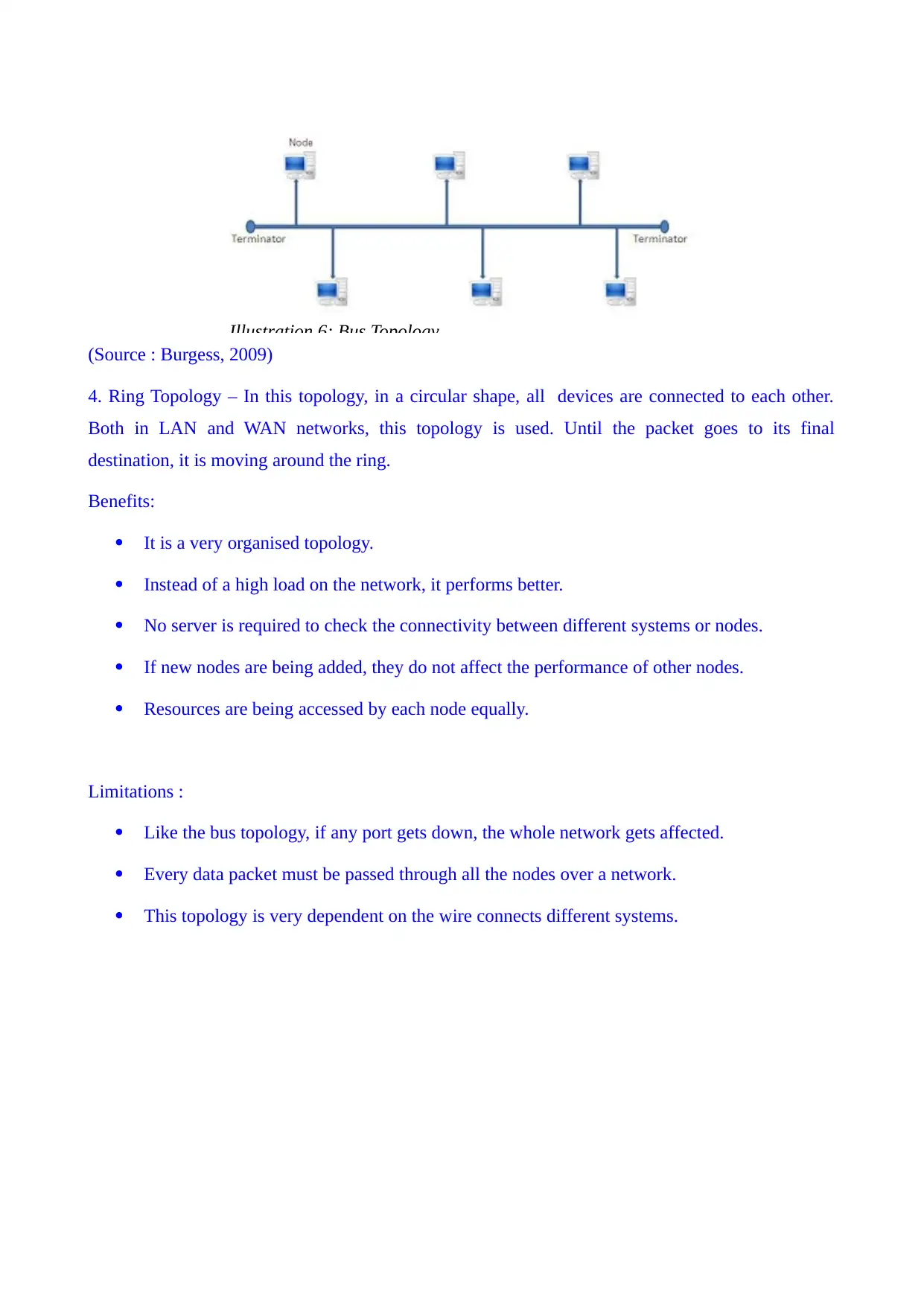
(Source : Burgess, 2009)
4. Ring Topology – In this topology, in a circular shape, all devices are connected to each other.
Both in LAN and WAN networks, this topology is used. Until the packet goes to its final
destination, it is moving around the ring.
Benefits:
It is a very organised topology.
Instead of a high load on the network, it performs better.
No server is required to check the connectivity between different systems or nodes.
If new nodes are being added, they do not affect the performance of other nodes.
Resources are being accessed by each node equally.
Limitations :
Like the bus topology, if any port gets down, the whole network gets affected.
Every data packet must be passed through all the nodes over a network.
This topology is very dependent on the wire connects different systems.
Illustration 6: Bus Topology
4. Ring Topology – In this topology, in a circular shape, all devices are connected to each other.
Both in LAN and WAN networks, this topology is used. Until the packet goes to its final
destination, it is moving around the ring.
Benefits:
It is a very organised topology.
Instead of a high load on the network, it performs better.
No server is required to check the connectivity between different systems or nodes.
If new nodes are being added, they do not affect the performance of other nodes.
Resources are being accessed by each node equally.
Limitations :
Like the bus topology, if any port gets down, the whole network gets affected.
Every data packet must be passed through all the nodes over a network.
This topology is very dependent on the wire connects different systems.
Illustration 6: Bus Topology
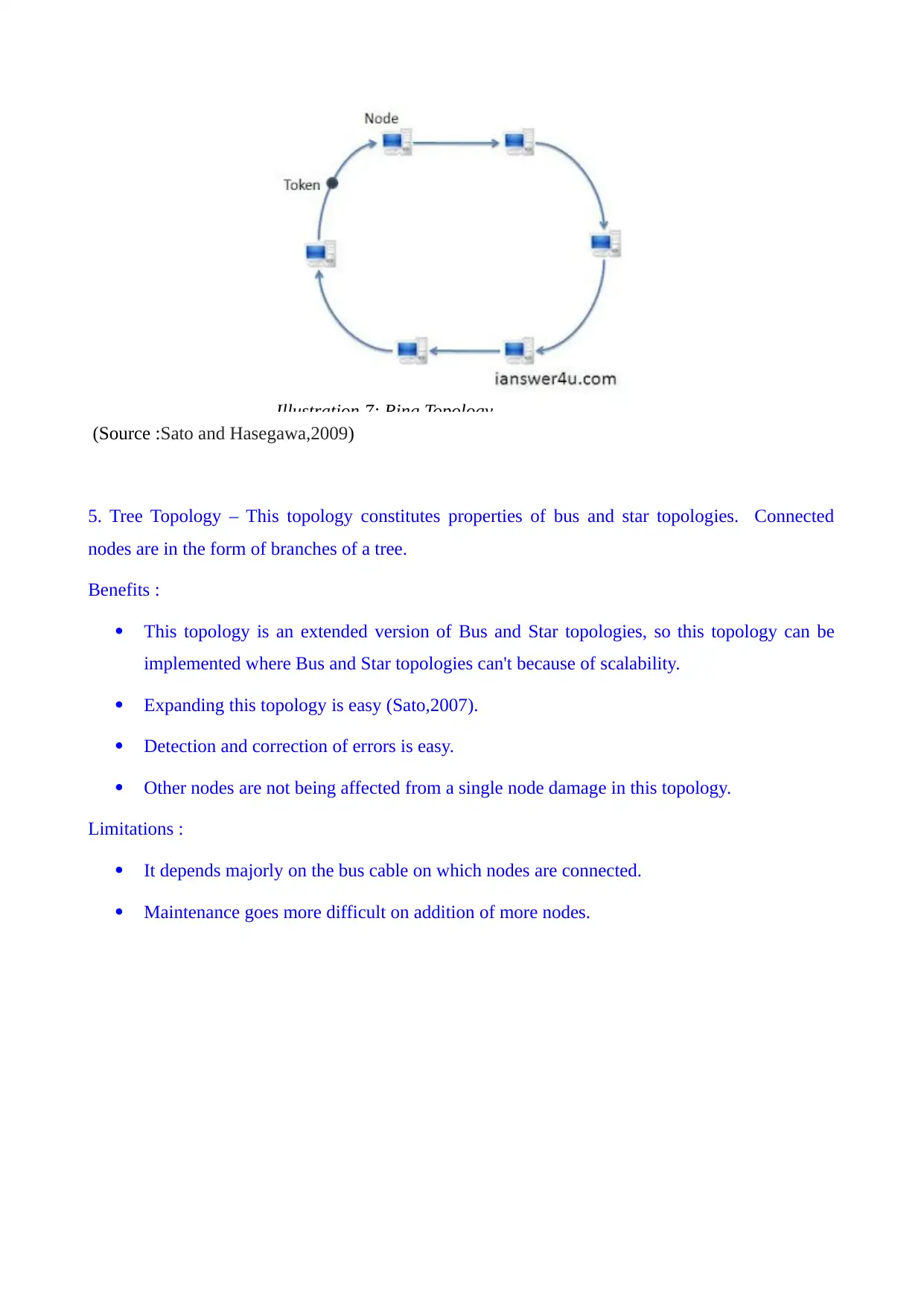
(Source :Sato and Hasegawa,2009)
5. Tree Topology – This topology constitutes properties of bus and star topologies. Connected
nodes are in the form of branches of a tree.
Benefits :
This topology is an extended version of Bus and Star topologies, so this topology can be
implemented where Bus and Star topologies can't because of scalability.
Expanding this topology is easy (Sato,2007).
Detection and correction of errors is easy.
Other nodes are not being affected from a single node damage in this topology.
Limitations :
It depends majorly on the bus cable on which nodes are connected.
Maintenance goes more difficult on addition of more nodes.
Illustration 7: Ring Topology
5. Tree Topology – This topology constitutes properties of bus and star topologies. Connected
nodes are in the form of branches of a tree.
Benefits :
This topology is an extended version of Bus and Star topologies, so this topology can be
implemented where Bus and Star topologies can't because of scalability.
Expanding this topology is easy (Sato,2007).
Detection and correction of errors is easy.
Other nodes are not being affected from a single node damage in this topology.
Limitations :
It depends majorly on the bus cable on which nodes are connected.
Maintenance goes more difficult on addition of more nodes.
Illustration 7: Ring Topology
⊘ This is a preview!⊘
Do you want full access?
Subscribe today to unlock all pages.

Trusted by 1+ million students worldwide
1 out of 19
Related Documents
Your All-in-One AI-Powered Toolkit for Academic Success.
+13062052269
info@desklib.com
Available 24*7 on WhatsApp / Email
![[object Object]](/_next/static/media/star-bottom.7253800d.svg)
Unlock your academic potential
Copyright © 2020–2025 A2Z Services. All Rights Reserved. Developed and managed by ZUCOL.





